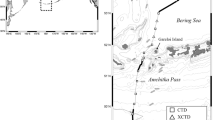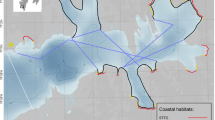Abstract
To understand the environmental factors affecting the density of foraging seabirds across the cold-water belt in the southwestern Okhotsk Sea, we conducted a 1-day (180-km transect length) shipboard seabird survey off the northeastern coast of Hokkaido during summer in 2019, along with acoustic observations of potential prey (zooplankton and fish) biomass, thermosalinograph measurements, and CTD observations. Planktivorous short-tailed shearwaters Ardenna tenuirostris (66% of total seabirds) and piscivorous rhinoceros auklets Cerorhinca monocerata (28%) were predominant, but foraged in contrasting habitats. A large foraging flock of shearwaters was observed in the cold-water belt zone, including its front with coastal Soya Warm Current Water and the offshore Fresh Surface Okhotsk Sea Water, where surface chlorophyll a concentrations were the highest but not related to their prey (zooplankton) biomass at any spatial scale between 4.6 and 9.2 km. In contrast, the density of auklets was high in the coastal Soya Warm Current Water, where the acoustically determined fish biomass was large, and showed a positive relationship with the fish biomass especially in the lower layer (29–104 m depth) at any spatial scale. This species-specific difference in response to prey biomass might be related to prey-searching behaviors; i.e., rhinoceros auklets search prey underwater visually, but short-tailed shearwater can use both visual and olfactory cues to locate zooplankton patches from the air.





Similar content being viewed by others
References
Baduini CL, Hunt GL Jr, Pinchuk AI, Coyle KO (2006) Patterns in diet reveal foraging site fidelity of short-tailed shearwaters in the southeastern Bering Sea. Mar Ecol Prog Ser 320:279–292
Biodiversity Center of Japan (2017) Monitoring site 1000 seabird investigation report fiscal year 2016. Nature Conservation Bureau, Ministry of the Environment, Fujiyoshida, Japan (in Japanese with English abstract)
Bost CA, Cotté C, Bailleul F, Cherel Y, Charrassin JB et al (2009) The importance of oceanic fronts to marine birds and mammals of the southern oceans. J Mar Syst 78:363–376
Burger AE, Wilson RP, Garnier D, Wilson MPT (1993) Diving depths, diet, and underwater foraging of Rhinoceros Auklets in British Columbia. Can J Zool 71:2528–2540
Dalpadado P, Arrigo KR, van Dijken GL, Skjoldal HR, Bagøien E, Dolgov AV, Prokopchuk IP, Sperfeld E (2020) Climate effects on temporal and spatial dynamics of phytoplankton and zooplankton in the Barents Sea. Prog Oceanogr 185:102320
De Robertis A, McKelvey DR, Ressler PH (2010) Development and application of an empirical multifrequency method for backscatter classification. Can J Fish Aquat Sci 67:1459–1474
Fauchald P, Erikstad KE (2002) Scale-dependent predator-prey interactions: the aggregative response of seabirds to prey under variable prey abundance and patchiness. Mar Ecol Prog Ser 231:279–291
Foote KG, Knudsen HP, Vestnes G, MacLennan DN, Simmonds EJ (1987) Calibration of acoustic instruments for fish density estimation: practical guide. ICES Coop Res Rep 144:57
Gaston AJ, Jones IL (1998) The Auks. Oxford University Press, Oxford
Harris RP (1988) Interactions between diel vertical migratory behavior of marine zooplankton and the subsurface chlorophyll maximum. Bull Mar Sci 43:663–674
Hasebe M, Senzaki M (2016) Records of seabirds breeding on Rebun Island, Hokkaido. Rishiri Stud 35:25–29 ((in Japanese with English abstract))
Hazen EL, Suryan RM, Santora JA, Bograd SJ, Watanuki Y, Wilson RP (2013) Scales and mechanisms of marine hotspot formation. Mar Ecol Prog Ser 487:177–183
Hokkaido national fisheries research institute (2017) Assessment of stock size of Japanese sand lance on soya straits in 2016. http://abchan.fra.go.jp/digests28/details/2851.pdf (Accessed 4 Feb 2021) (in Japanese)
Holland GJ, Greenstreet SPR, Gibb IM, Fraser HM, Robertson MR (2005) Identifying sandeel Ammodytes marinus sediment habitat preferences in the marine environment. Mar Ecol Prog Ser 303:269–282
Hooker SK, Gerber LR (2004) Marine reserves as a tool for ecosystem-based management: the potential importance of megafauna. Bioscience 54:27–39
Hunt GL Jr, Schneider D (1987) Scale-dependent processes in the physical and biological environment of marine birds. In: Croxall JP (ed) Seabirds: feeding ecology and role in marine ecosystems. Cambridge University Press, Cambridge, pp 7–41
Hunt GL Jr, Heinemann D, Everson I (1992) Distributions and predator-prey interactions of macaroni penguins, Antarctic Fur seals, and Antarctic krill near Bird Island, South Georgia. Mar Ecol Prog Ser 86:15–30
Hunt GL Jr, Coyle KP, Hoffman S, Decker MB, Flint EN (1996) Foraging ecology of short-tailed shearwaters near the Pribilof Islands, Bering Sea. Mar Ecol Prog Ser 141:1–11
Hunt GL Jr, Baduini C, Jahncke J (2002) Diets of short-tailed shearwaters in the southeastern Bering Sea. Deep-Sea Res II 49:6147–6156
Iida H, Isoda Y, Kobayashi N, Horio K (2018) Observation and model experiments of the diurnal eddy of the Cold Water Belt along the Offshore Side of the Soya Warm Current. Umi No Kenkyu 27(4):155–174
Ishizu M, Kitade Y, Matsuyama M (2006) Formation mechanism of the cold-water belt formed off the Soya Warm Current. J Oceanogr 62:457–471
Ishizu M, Kitade Y, Matsuyama M (2008) Characteristics of the cold-water belt formed off Soya warm current. J Geophys Res 113:C12010
Ito M, Minami H, Tanaka Y, Watanuki Y (2009) Seasonal and inter-annual oceanographic changes induce diet switching in a piscivorous seabird. Mar Ecol Prog Ser 393:273–284
Kazama K, Nishizawa B, Tsukamoto S, Gonzalez JE, Kazama MT, Watanuki Y (2018) Male and female Black-tailed Gulls Larus crassirostris feed on the same prey species but use different feeding habitats. J Ornithol 159:923–934
Kokubun N, Iida K, Mukai T (2008) Distribution of murres (Uria spp.) and their prey south of St. George Island in the southeastern Bering Sea during the summers of 2003–2005. Deep-Sea Res Part II 55:1827–1836
Kondratyev AY, Litvinenko NM, Shibaev YV, Vyatkin PS, Konfratyeva LF (2000) The breeding seabirds of the Russian Far East. In: Kondratyev AY, Litvinenko NM, Kaiser GW (eds) Seabirds of the Russian Far East. Special Publication, Canadian Wildlife Service, Ottawa, pp 37–81
Korneliussen RJ (2018) Acoustic target classification. ICES Coop Res Rep 344:104. https://doi.org/10.17895/ices.pub.4567
Kurasawa K, Honda S, Watanuki Y (2011) Distribution of migrating short-tailed shearwater and breeding rhinoceros auklet and their prey in the northern Sea of Japan, Hokkaido in spring. Jpn J Ornithol 60:216–227
Kuroki M, Kato A, Watanuki Y, Niizuma Y, Takahashi A, Naito Y (2003) Diving behavior of an epipelagically-feeding alcid, the rhinoceros auklet (Cerorhinca monocerata). Can J Zool 81:1249–1256
Moeller HV, Laufkötter C, Sweeney EM, Johnson MD (2019) Light-dependent grazing can drive formation and deepening of deep chlorophyll maxima. Nat Commun 10:1978
Nakanowatari T, Ohshima KI, Mensah V, Mitani Y, Hattori K, Kobayashi M, Roquet F, Sakurai Y, Mitsudera H (2017) Hydrographic observations by instrumented marine mammals in the Sea of Okhotsk. Polar Sci 13:56–65
Nevitt GA, Veit RR, Kareiva P (1995) Dimethyl sulphide as a foraging cue for Antarctic procellariiform seabirds. Nature 376:680–682
Nishizawa B, Matsuno K, Labunski EA, Kuletz KJ, Yamaguchi A, Watanuki Y (2017) Seasonal distribution of short-tailed shearwaters and their prey in the Bering and Chukchi seas. Biogeosciences 14:203–214
Nishizawa B, Yamada N, Hayashi H, Wright C, Kuletz KJ, Ueno H, Mukai T, Yamaguchi A, Watanuki Y (2020) Timing of spring sea-ice retreat and summer seabird-prey associations in the northern Bering Sea. Deep-Sea Res II 182:104898
Ogi H, Kubodera T, Nakamura K (1980) The pelagic feeding ecology of the Short-tailed Shearwaters Puffinus tenuirostris in the Subarctic Pacific Region. J Yamashina Inst Ornithol 12:157–182
R Development Core Team (2020) R: a language and environment for statistical computing. R foundation for statistical computing, Vienna, Austria. http://www.R-project.org/
Reiss CS, Cossio AM, Loeb V, Demer DA (2008) Variations in the biomass of Antarctic krill (Euphausia superba) around the South Shetland islands, 1996–2006. ICES J Mar Sci 65:497–508
Safruddin (2013) Estimates of Japanese sandeel (Ammodytes personatus) distribution and biomass in the northern coast of Hokkaido, Japan, using a quantitative echo sounder. Doctoral thesis, Graduate School of Fisheries Sciences, Hokkaido University.
Santora JA, Ralston S, Sydeman WJ (2011) Spatial organization of krill and seabirds in the central California Current. ICES J Mar Sci 68:1391–1402
Savoca MS, Nevitt GA (2014) Evidence that dimethyl sulfide facilitates a tritrophic mutualism between marine primary producers and top predators. Proc Natl Acad Sci USA 111:4157–4161
Schneider DC (1990) Spatial autocorrelation in marine birds. Polar Res 8:89–97
Sokal RR, Oden NL (1978) Spatial autocorrelation in biology 1. Methodol Biol J Linn Soc 10:199–228
Suryan RM, Sato F, Balogh GR, David Hyrenbach K, Sievert PR, Ozaki K (2006) Foraging destinations and marine habitat use of short-tailed albatrosses: a multi-scale approach using first-passage time analysis. Deep Sea Res II 53:370–386
Sydeman WJ, Brodeury RD, Grimes CB, Bychkov AS, McKinnell S (2006) Marine habitat “hotspots” and their use by migratory species and top predators in the North Pacific Ocean: introduction. Deep Sea Res II 53:247–249
Takahashi A, Kuroki M, Niizuma Y, Kato A, Saitoh S, Watanuki Y (2001) Importance of the Japanese Anchovy (Engraulis japonicus) to breeding Rhinoceros Auklets (Cerorhinca monocerata) on the Teuri Island, Sea of Japan. Mar Biol 139:361–371
Takizawa T (1982) Characteristics of the Soya Warm current in the Okhotsk Sea. J Oceanogr 38:281–292
Tanaka H, Kajiwara T (1979) The distribution of Fulmarus glacialis and Puffinus tenuirostris, in the North Pacific Ocean and the Okhotsk Sea during the summer. J Yamashina Inst Ornith 11:79–86 ((In Japanese with English summary))
Tasker M, Jones PH, Dixon T, Blake B (1984) Counting seabirds at sea from ships: a review of methods employed and suggestions for a standardized approach. Auk 101:567–577
Townsend DW, Cucci TL, Berman T (1984) Subsurface chlorophyll maxima and vertical distribution of zooplankton in the Gulf of Maine. J Plankton Res 6:793–802
Watanuki Y (1987) Breeding biology and foods of Rhinoceros Auklets on Teuri Island, Japan. Proc NIPR Symp Polar Biol 1:175–183
Wright PJ, Jensen H, Tuck I (2000) The influence of sediment type on the distribution of the lesser sandeel, Ammodytes marinus. J Sea Res 44:243–256
Yamamoto T, Hoshina K, Nishizawa B, Meathrel CE, Phillips RA, Watanuki Y (2015) Annual and seasonal movements of migrating short-tailed shearwaters reflect environmental variation in sub-Arctic and Arctic waters. Mar Biol 162:413–424
Acknowledgements
We thank the captain, officers, and crews of the T/S Oshoro-maru for their help with field surveys. Keizo Ito and Sarufutsu Fishery Cooperative provided marine information on the study region. Nodoka Yamada helped with acoustic data analysis. We also thank two anonymous referees for their helpful comments that greatly improved the manuscript. This study was supported by JSPS KAKENHI Grant Number 20H03054 (Y. Mitani) and 19J01267 (B. Nishizawa) and by the Environment Research and Technology Development Fund (JPMEERF20214002) of the Environmental Restoration and Conservation Agency of Japan.
Author information
Authors and Affiliations
Corresponding author
Additional information
Publisher's Note
Springer Nature remains neutral with regard to jurisdictional claims in published maps and institutional affiliations.
Rights and permissions
About this article
Cite this article
Nishizawa, B., Okado, J., Mitani, Y. et al. Two species of seabirds foraged in contrasting marine habitats across the cold-water belt along the coast of northern Hokkaido in the southwestern Okhotsk Sea. Fish Sci 88, 109–118 (2022). https://doi.org/10.1007/s12562-021-01576-9
Received:
Accepted:
Published:
Issue Date:
DOI: https://doi.org/10.1007/s12562-021-01576-9




